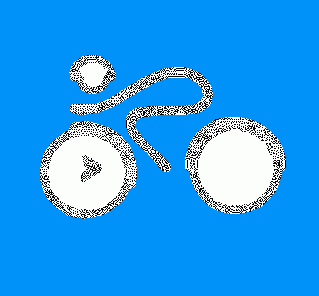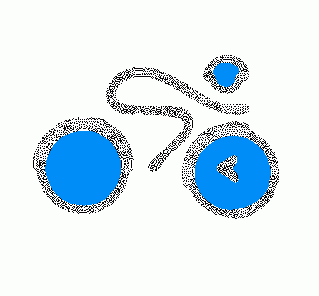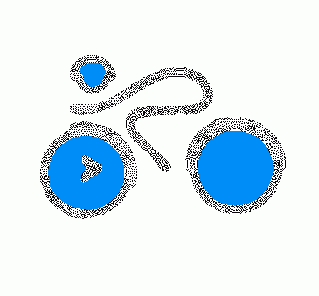| Newsletter - 2001 Archive |

|

|
Cycling Club |

|

|
| Newsletter - 2001 Archive |

|

|
Cycling Club |

|

|
Next--->
Well, it's unanimous. In my growing catalog of unpopular ideas about how to improve randonneur cycling, the lack of popularity for this idea has broken new ground. Through e-mails, casual conversations, and in the three counter-argument pieces written for the newsletter, club members have made it clear that any change to existing time limits rules is a non starter.
Before putting this to bed forever, there were some interesting ideas, and some alternative points of view, that surfaced regarding time limits that are worth sharing. First I would like to offer a brief rebuttal to the two refutations published in the last newsletter by Danelle and by Kent Peterson from Seattle.
Danelle begins by saying "To popularize our sport or not? This is one of the questions that Eric is raising in his article on time limits." Well perhaps I do suggest this by inviting a comparison with marathon running, but I'm not really talking about popularizing randonneur cycling in this article. In fact I have a little confession to make to the club at this point. When people have called for information about the sport there are often hesitations: "Is it dangerous to ride at night, do people crash and become seriously injured, are there bears, does long distance cycling cause impotence, is it true what they say about cycling and prostate problems?, etc." My response has become fairly consistent: "This is a difficult and dangerous sport and if you have any hesitations you probably shouldn't become involved. There are a lot of ways to have fun on bikes. There's this fantastic group called the Vancouver Bicycle Club (I'm assuming a Lower Mainland inquiry obviously] and many of us are members. There's this very nice guy named Bruce Hainer and here is his number."
Rather than popularizing randonneur cycling, I'm afraid I have to take some responsibility for keeping the numbers manageable over the past four years. What I was getting at with the time limits thing was not to get more people involved necessarily, but rather to be less exclusive - to include people that our present time limit demarcations, which I regard as arbitrary, shut out. My point is that cyclists simply come in different speeds, and I think we should make every effort to ensure that our rules reflect this.
Another point made by Danelle, and echoed passionately by Kent Peterson, was the idea that finishing within the time limits is part of the challenge of randonneur cycling. Kent observes: "The challenge is not [to] ride 200 km. It is [to] ride 200 km, on this course, on this date, hitting these check points within these limits." Danelle goes so far as to suggest "that opening up the time limit on this event [the Rocky Mt. 1200] would kill it." This is a notion I can't agree with. Sure, for a small percentage of riders who find themselves close to the slow end limit, this limit represents a goal or a challenge. This is clearly not a universal sentiment - my guess is that the vast majority of randonneurs ride brevets oblivious to the slow end time limit, and yet still regard the rides as challenging. I suggest that we, some of us anyway, have become addicted to our present arbitrary slow end time limit, and that if it was placed differently - slower or faster, take your choice - people, albeit a different group of people, would become attached to, and then addicted to the new limit as well. Why not set the limit to include as many people as is practical from an organizational stand point, and free people to define their own challenges.
And, of course, Harold has a few thoughts on the subject. One point raised by Harold which I should clear up, is the question of the PBP fast end time limit policy. The rule is as I stated in my original article: "There is no fast end limit for the '80 hour' group at PBP." Harold correctly points out that both opening and closing times are published (they're in the PBP rules and recommendations package, schedule J1), but the opening times are qualified with the statement "The opening of the checkpoint being free, these times are just an indication." In the context of the rest of the material being distributed in the PBP information package, these opening time designations can be seen as a guide for support persons.
The most involved of the e-mail responses I received was from Wayne Harrington who is also firmly against relaxing the slow-end time limit. Wayne has clearly done a lot of thinking, not only on the question of time limits, but a number of other related issues. One particularly interesting notion was his suggestion to include "'dead' time breaks" for multi-day randonneur events: "In events like the Iditarod and Yukon Quest [dog sled races] there is a mandatory 24 hour stop to allow competitors to get adequate rest and sleep before continuing on... Using a 600 km event as an example, with a motel break at 350 km, the riders would ride to the motel break, as is currently done, using the current time limits. At the motel each rider would have the option of stopping for up to six hours without this time being counted against their event time. Upon leaving the motel control, their next time limit would be departure time plus the 15 km time limit for the distance to the next control."
I received a very informative e-mail from Sheila Simpson of Audax UK. She managed to pack a lot of new (new for me at least) information into her short message about the situation in France and the UK, but I will mention just a few points. She began by saying: "In the UK we cling to the upper speed limit (and we use a flat 30 kph between all control points, not overall as in France) as a means of differentiating randonnees from road races." There are several noteworthy things here. First of all, 30 kph is different than our 32 kph (for a 600) or 34 kph (for a 200) - I didn't realize there were international variations on the time limits. Secondly, the words "not overall as in France" kinda jump out at you, don't they? If our fast-end time limit was for overall time, and not for the checkpoints, the problem of riders standing around at early checkpoints on flat courses would be virtually eliminated, and all within the existing rules of randonneur cycling as it is practiced in France. It is worth pointing out that neither Ted nor Keith have ridden a 200 km brevet faster than 6 hours (although they have both ridden sub-6 hr non event 200 km rides) Our existing fast end time limit for 200 is 5:53, out of reach (?) for even Keith and Ted. I could live with this. Switching the fast end time limit to the overall brevet time, and eliminating control opening times, is a minor rule change I think we should consider.
And this was interesting... Ms. Simpson also pointed out that there are French randonneur-like events with different time limits: "There are events in France (not ACP's) with three levels of riding, Cyclo Sportif, Randonneur, and Cyclo Touriste (for the event I rode the times were something like under 12 hours, under 18 hours, and 2 days with an overnight stop, for a mountain 200 km) and I guess that this system might suit you in Canada if you could find organizers willing to do it. You'll probably find that ACP are not interested in any standard other than the Randonneur though, so you would have to institute your own validation, say, Brevet Cyclotouriste. Nothing wrong with that!"
On the subject of persuading ACP to change its present formula, Jennifer Wise, of Randonneurs USA put it most succinctly in her e-mail: "It has been my experience that the French are steeped in tradition and are not open to rule changes. Suffice it to say, that the time limits are part of the game. If you want to play, you play by the rules. If not, you don't have to play."
I started by saying that opposition within the club to moving the limits was unanimous. That's not entirely true. At the eleventh hour I received an e-mail from Tom Hocking (who wrote that excellent article on pace line protocol, remember?). His situation has perhaps allowed him to look at the issue from a unique angle. Here's a little of what he said: "Greg Lemond once said something like, '...Yes, some of us do go faster than some others, but we all suffer to the same extent' [italics Tom's]. Be it resolved that randonneuring is not 'racing' - perhaps we still need some 'standard' of achievement that allows slower/older riders equal recognition with the young hammerheads. Jeez, I think Harold deserves some recognition for his persistence in the face of adversity. Due to a genetic defect in my cardiovascular system, I've been riding with an unfair disadvantage that requires me to train systematically year 'round just so I can hope to stay mid-pack. I average ~9,000 "training" km/year and work out in the weight room, and I'm likely as not still off the back and suffering halfway up the first steep hill."
Tom doesn't actually seem to have had that much trouble keeping inside the slow-end time limit, but his case can help us to imagine a rider who despite a systematic training schedule, knowledge and experience, and the all-important willingness to endure suffering on a bicycle, may still find the slow end time limit too demanding.
And funny he should mention Harold... Although I was certain that Harold would be firmly against the idea of changing time limits rule, he was in fact very much on my mind when I wrote my original article. At last June's stormy Princeton, Merritt, Fraser Canyon 600, despite atrocious conditions (I had both rain and hail through the mountains), Harold managed to handle Alison Pass and Sunday Summit and make it to the Princeton control before the closing. His decision to abandon in Princeton was not because of the terrain or the weather - the worst was behind him - but because he felt it was unlikely that he would reach the Merritt control before the cut off. In August, Harold and Bob Bose came within a whisker of completing the Newhalem, Oak Harbor 600, and when they called it quits (at 533 km) the long shadow of closing time limit was again looming. Either of these 600s would have given Harold his Super Randonneur pin. All I could think was "darn, too bad he didn't have just a little more time."
And those 'young hammerheads' to whom Tom refers? Well, if you take a look at Harold's time trial times from half a century ago, it's not hard to imagine him as one of those 'young hammerheads' (hypothetically of course - he was not a randonneur back then.) The fact that it is possible, in the cycle of our lives, for the same person to collide with both time limits is perhaps an illustration of just how narrow the window is.
I guess the point I'm staggering towards is my original point from the earlier article. It is obvious that age, sex, wealth, and a myriad of other biological and social factors all affect our speed, but fundamentally these things are peripheral to that which is the essence of randonneur cycling. In this sport we use these time limits as a way of defining ourselves as special - or at least this is true for those of us who are comfortably within the boundaries. We also use the limits as walls to keep people out that don't fit. To return to the age example, our time limits are a convenient way to put out to pasture all but the most exceptional cyclists in their sixties, seventies, (and eighties?) who don't quite measure up on a scale tailored for fifty year olds. To me this feels like discrimination. I am aware that there are practical consequences to the idea of relaxing the time limits. Interestingly though, the passionate defenses that pushed this debate over 5 on the Richter scale were more ideological than practical in nature. I still don't think that our present time limits are borders that are worth defending, but to look on the bright side, I find myself comfortably within those borders...for the moment.
So from my point of view, this proposal to relax the time limits is as dead as toe clips. There's still lots of room for fun in this sport, and so I will happily take my porridge the same as the next randonneur - not too hot, not too cold, but juuuust right.
_